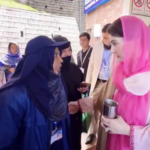NEW YORK, Feb 02 (APP):Hate crimes in major US cities rose for the fifth consecutive year in 2018, fueled in large part by attacks on African-Americans, Latino communities and Jews, according to a new report.There were a total of 921 bias incidents in nine of the 10 largest U.S. cities last year, up 14 percent from 2017, according to data compiled by the Center for Hate and Extremism at California State University in San Bernardino. The study used police department data from around the country.
Hate crime data for Phoenix, the fifth-largest U.S. city, were unavailable, but police departments in nearly 20 other cities reported an overall increase in bias incidents, the report said.
Among the nation’s largest cities, bias incidents rose 6 percent in New York City, 13 percent in Los Angles, 26 percent in Chicago and a startling 173 percent in Houston, according to the data. Blacks, Jews and gays were the top three targets of hate crimes in Chicago, the data show.
Brian Levin, director of the center, said that while the overall hate crime figures for 2018 could change as more data come in, the trend in bias-motivated incidents in the U.S. remains up.
“We’re seeing an unmistakable trend of increases,” Levin said. Last year’s increase in hate crimes “shows that we’re in a new era that started four or five years ago.”
Despite the overall increase in hate crimes, the report said that attacks targeting Muslims in New York, Chicago and Los Angeles fell.
According to the FBI, anti-Muslim hate crimes dropped by 13 percent in 2017 after rising sharply over the previous two years.
In November, the FBI reported that hate crimes in the United States rose by 17 percent in 2017, the largest increase in bias incidents since the attacks of Sept. 11, 2001. The increase marked the third straight year that U.S. bias incidents rose. More than 50 percent of the victims of the attacks were African-American, 21 percent were targeted because of their religion and 16 percent were attacked because of their sexual orientation.
The FBI defines a hate crime as a “criminal offence against a person or property motivated in whole or in part by an offender’s bias against a race, religion, disability, sexual orientation, ethnicity, gender or gender identity.” Some of the 2018 increase in hate crimes was due to better reporting by police departments. But Levin said other factors, including “the coarse sociopolitical climate,” demographic changes and a resurgence of white nationalism played bigger roles in driving the surge.
African-Americans and Jews remained the most targeted groups. In New York City, home of the largest American Jewish population, more than half of the 361 hate crimes recorded in 2018 targeted Jews, according to city police data. And of the 189 anti-Semitic incidents, 150 involved the displaying of swastikas.
Some of the anti-Semitic incidents including vandalism came in the aftermath of a Pittsburgh synagogue massacre that left 11 people dead in October 2018 — the deadliest anti-Semitic shooting in U.S. history. While the mass shooting in which white supremacist Robert Bowers sparked national outrage, it appears to have provided an incentive for further anti-Semitic attacks.
The Anti-Defamation League, a Jewish organization that tracks anti-Semitism in the United States, recorded an increase of 57 percent in anti-Semitic incidents in 2017, the largest single-year increase on record. ADL said in a report last year that there was a “significant increase in incidents in schools and college campuses” last year.







